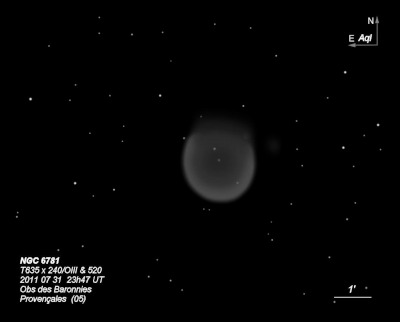
William Herschel discovered NGC 6781 = H III-743 = h2037 on 30 Jul 1788 (sweep 850) and recorded "cF, irregularly round, 3 or 4' diam, resolvable." John Herschel made a detailed observation on 15 Aug 1830 (sweep 280): "A most beautiful, vL, F planetary nebula. Diameter in RA = 6.5 seconds = 1' 37"; its light nearly uniform, only very little hazy at the edge and perhaps rather brighter at the southern limb. It nature seems to have been overlooked or mistaken by my Father, who has placed it in his third class [Very Faint Nebula]. In Milky Way. Many stars in field, one 11m near the north-following limb." On 28 Aug 1850, Lord Rosse (or assistant) described the planetary as "annular or perhaps spiral, star distinctly seen in dark part n of centre, others seen at moments. The dark space is undoubtedly irr in form."
Johann von Lamont made a sketch on 7 Jul 1837 with the 11" Merz refractor at the Munich Observatory. William Lassell observed the planetary on Malta with his 48" reflector and made a sketch on 29 Aug 1862. Another sketch was made around 1877 by Wilhelm Tempel with the 11" refractor at Arcetri Observatory in Florence. Temple compared his results with Lamont and Lassell. E.E. Barnard described the planetary as annular using the Yerkes 40" refractor in 1899.
Based on Crossley photographs at Lick, Curtis (1918) reported "this object is `06" in diameter from east to west, and a little longer than this along a major axis in approximately p.a. 5°. Exceedingly faint at the north; brightest at east and west edges, and fainter along the major axis. Indistinct ring structure shown around edges."
200/250mm - 8" (7/24/82): large and easily viewed but the annularity was not seen with any certainty.
300/350mm - 13.1" (6/29/84): the rim is brighter mainly on the SW side giving a slightly annular appearance. A faint star is off the east edge.
13.1" (8/15/82): brighter rim mostly evident on the south side and a darker center just visible at 140x-200x.
400/500mm - 17.5" (6/30/00): at 220x unfiltered this fairly bright PN has a 1.5' round halo. The rim is brightest and more well-defined along an arc on the south and southeast rim. The central 45" hole is slightly darker and irregular in surface brightness. A mag 13 star is at the northeast edge and once or twice I caught a fainter glimmer of an interior star north of center.
17.5" (7/12/99): at 100x appears fairly bright, round, ~1.6' diameter with a darker center. I used a variety of magnifications and filters but the most interesting view was at 220x using a UHC filter. With this combination the PN is slightly elongated E-W and clearly brighter along the southern rim with the brightening tapering towards the ends so this brighter portion had a crescent appearance. Because of this asymmetric rim the darker center seems offset and only weakly brightens at the NW rim. A mag 13 star is just off the NE edge 1' from center.
17.5" (8/2/86): at 222x and UHC filter; very large, about 1.8' diameter, much brighter on the SW portion of the rim, darker center. A mag 13 star is just off the NE edge.
600/800mm - 24" (6/30/16): at 322x and 500x; fairly bright and large, round, just under 2' diameter. Contains a relatively thick, much brighter rim, except on the north side. The annulus is unevenly in surface brightness, but brighter along a 180° arc, centered on the side south and dimming gradually but extending ~240°. This gives the planetary a "C" shape appearance. The remaining 120° arc, centered on the north edge, is noticeably fainter. A mag ~13.5 star is at the northeast edge, a mag ~14.5 star is just off the north-northwest edge and a mag 15.5+ star is barely off the south edge. An extremely faint star is superimposed just north-northeast of center (probably not the central star).
Notes by Steve Gottlieb